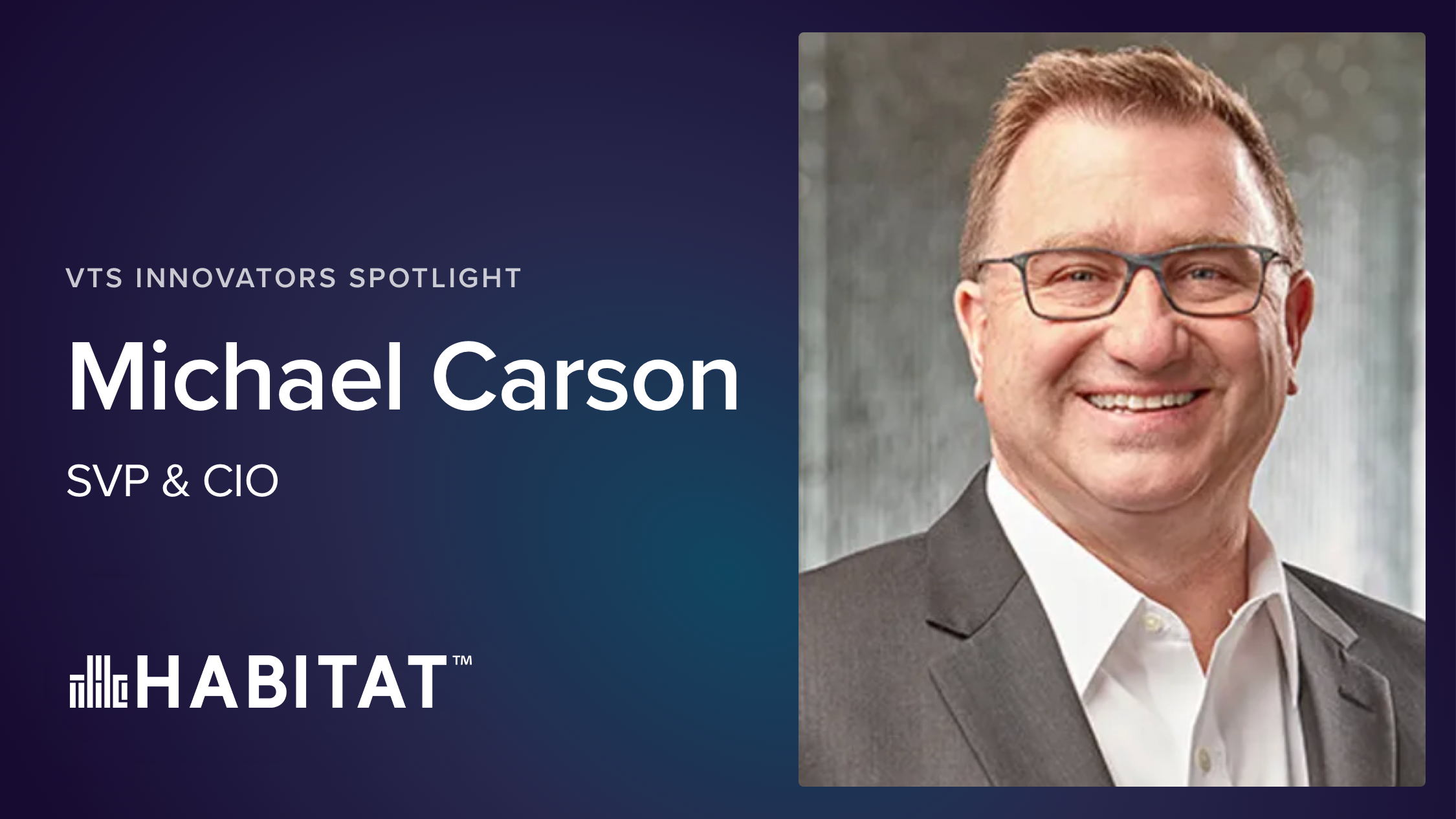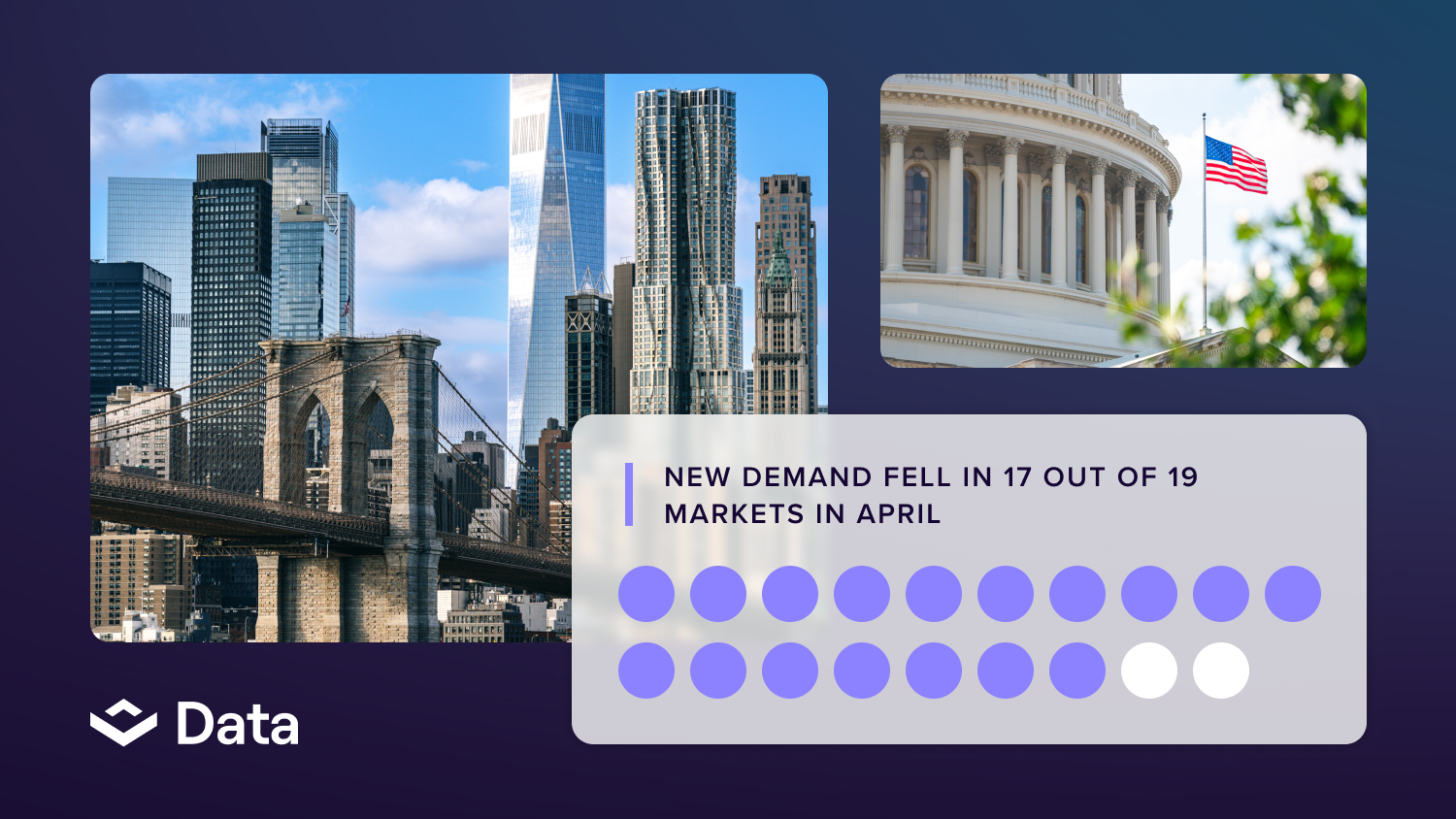In this edition of the VTS Innovators Spotlight, we sat down with Michael Carson — Chief Information Officer at The Habitat Company, and early customer of VTS Rise (now VTS Activate for Multifamily) — to talk about how emerging technology continues to shape the multifamily sector and the importance of leveraging the right partners.
Hey Michael! Thank you for taking the time to chat. The role of Chief Information Officer has become more common across multifamily in recent years, but it probably means different things across different companies. How would you describe your role and the outcomes you focus on for Habitat?
As the Chief Information Officer at Habitat, my role is pivotal in steering our organization toward our always-evolving technology needs. At its core, my role aligns technology strategies with business objectives so we can support current solutions, enhance efficiencies for our operations teams, and stay ahead of the curve with new technology as it emerges.
My responsibilities are comprised of overseeing the execution of Habitat’s technology roadmap, which includes everything from cybersecurity to data warehousing and from operational standards to identity management. I'm also involved in leveraging our innovative technologies to support the proficiencies we look to gain for our onsite teams.
We’ve developed a robust and scalable cloud environment that provides a seamless experience for our onsite teams as well as our regional corporate offices. This outcome involves balancing emerging trends with future needs and implementing solutions that support our growth. Moreover, I play a crucial role in managing data, ensuring its security, and leveraging it for strategic decision-making. Whether we're implementing advanced analytics or enhancing our data governance practices, we strive to turn information into an asset that can contribute to our overall success.
Awesome, thank you for that! So, getting more into Habitat — Habitat has long been an acquisitive company. From a building technology standpoint, what is the biggest challenge in bringing new assets onto the portfolio? Are there common obstacles to overcome regarding new vendor management and bringing assets to Habitat’s resident experience standards?
So, I'm going to start at a 50,000-foot view. The most common obstacle we're presented with as we implement our standard solution set across new properties is the diverse technology ecosystems we encounter at each one. Depending on the solution we're employing, there are numerous challenges involving capital, infrastructure, and onsite resources. Harmonizing different platforms, legacy systems, and varying standards is quite a challenge. At Habitat, we say that balance is both an art and a science. We have the art — the operational side — and then we have the science — the tech side.
While each acquisition brings a unique set of challenges, we've developed a strategic and systematic approach to overcoming obstacles and integrating these assets as seamlessly as possible. Our goal is to maintain a cohesive landscape across our entire portfolio. Ultimately, we are enhancing the Habitat experience for both our team members and the residents.
Another key challenge is dealing with the realm of our vendor management. Coordinating with a variety of vendors and aligning their services with our established standards is very complex. We find that establishing clear communication channels, standardizing processes, and ensuring that vendors adhere to our protocols are crucial to overcoming it.
On the standardization topic, I'm curious about two things. One, how often are you looking at the standard process and revising that? And two, how much do emerging technologies change the formula?
It's about balancing what the organization can absorb and what is necessary to keep us competitive. We have several committees that, driven by the needs of the operational teams, constantly review processes as well as introduce different solutions. Once decisions are in place, IT provides that foundational support to implement the product, making sure it will work in our infrastructures. Technologies are constantly evolving, and we’re evolving alongside them, so incorporating them has always driven our process.
Interesting! In regards to emerging technologies — what are you most excited by, especially as it pertains to the resident experience?
For me, it’s the AI and smart home technologies that provide an automated touchless experience throughout the resident journey. This is something we strive to put in place in all our communities. This excitement is rooted in the transformative potential these technologies have in automating and streamlining various aspects of living in our communities.
Specific to Habitat, the AI experience begins at the very first interaction a prospect has with our communities. AI-driven systems can schedule tours, intelligently answer questions, and highlight features that align with the prospect's preferences and needs. This approach not only makes the prospect's experience more engaging but also significantly more efficient, catering to their unique interests and schedules. Moving to smart home technology, features like smart locks and community- wide managed Wi-Fi facilitate easy guest access and foster a more connected community environment.
The blend of AI and smart home technologies represents a significant leap forward in enhancing the resident experience. From personalized interactions during the prospect phase to a convenient, connected, and efficient living experience for residents, these technologies are at the forefront of redefining modern living in our communities. Our commitment is to continuously explore and integrate these emerging technologies to ensure our residents enjoy a living experience that is not just comfortable but also cutting-edge.
It appears tech consolidation at the building level is a big efficiency play for multifamily owners right now, given the squeeze on rent growth and cost of capital. What’s your view of consolidation, both pros and cons?
We consolidate, not only from a technology and process standpoint, but also from a resource standpoint. That makes it even more relevant to utilize appropriate technologies and solutions to gain efficiency and do more with less. Habitat operates on what I'll call a best-of-breed stack, and we attempt to consolidate as much as possible while not keeping all our eggs in one basket.
From a positive perspective, we found that as we consolidate, we gain efficiency by streamlining operations, reducing redundancy, and simplifying management with optimized workflows. Consolidation also allows us to realize cost savings due to economies of scale, volume discounts, and streamlined maintenance. When we consolidate the tech stack, it allows for standardized processes and easier integration between the systems. This has enabled seamless data sharing, better analytics, and a more holistic view of building operations. Finally, centralized systems offer greater control and oversight, facilitating better security measures and compliance with industry standards and regulations.
On the other hand, when consolidation requires a heavy initial investment in equipment, training, and transition costs, it's potentially not viable for all communities in a portfolio. Also, relying on a single vendor for various services poses additional risks. Locking your company in with a vendor could require a heavy lift to move, make you vulnerable to service disruptions, or hinder progress with a lack of innovation.
That makes a lot of sense! What advice would you give to owners currently evaluating resident experience technology solutions? What factors should owners consider during the selection process beyond feature and capability requirements?
When selecting the right partner for resident technology solutions, we look for several factors. First, we look for a vendor that demonstrates a commitment to a long-term partnership rather than just buying a set-it-and-forget-it product. We feel that a partner invested in success and growth is one that provides sustained improvements in the resident experience space, and our VTS Activate for Multifamily partner has continued to do that.
Next, we look for partners that offer customizable solutions tailored to specific needs. The ability to customize features and functionalities ensures alignment with our specific property management strategies; this is another element of our partnership with VTS Activate for Multifamily that we have heavily utilized.
We also consider if the vendor’s support services, their training offerings, and the resources available will provide a turnkey experience. Finally, we assess the vendor's track record, look at their reputation in the industry, and their reliability in providing consistent support and service. Customer reviews, case studies, and references offer valuable insights into performance, scalability, and commitment.
I'll give you the perfect case study:
When we engaged VTS, we existed in several lines of business including condominium, which has a different legal standing for renters as compared to owners. VTS worked with us to develop a system where the renter would be able to live and function in the building without compromising the board rules and regulations. Without that flexibility from VTS, we would have needed to construct a different solution from multiple sources.
Final question, please fill in the blank: ___ is what will separate the winners and losers in multifamily leasing over the next five years.
There’s a lot to unpack here. The winners in the multifamily leasing sector will be the leaders who utilize emerging technologies. Their focus should be on enhancing the resident experience and streamlining operations. This approach will optimize property management processes, thereby transforming traditional leasing methods into modern, efficient, and resident-centric practices. Harnessing AI for predictive analytics and targeted marketing strategies, implementing self-service portals for resident convenience — which we've been using with VTS Activate for Multifamily — and utilizing smart connected devices for enhanced property management will become integral for successful organizations.
I think the winners will stand out by their proactive approach to embracing emerging technology and sustainability initiatives, incorporating eco-friendly features into their properties, and catering to the rising demand for environmentally and socially conscious living spaces.






